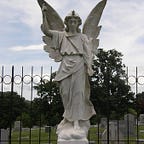The Legend of the Headless Railroad Man and the Ghost Lights of Maco Station
The days are getting warmer in North Carolina, but telling of the mystery of the ghost lights of Maco Station may put a shivery chill in the air. Have you ever heard of the gruesome death of railroad worker Joe Baldwin?
It is said that one night back in 1867 in Brunswick County, perhaps a rainy or misty night, a tragic train accident occurred along a swampy stretch of the Wilmington and Manchester Railroad just west of Wilmington, killing brakeman Joe Baldwin. The caboose he was in was hit by a train from behind, catapulting the man from the train and decapitating him.
Alone in the train’s last coach, Baldwin apparently must have realized that it had come loose from the rest of the train and that another train was close behind and so grabbed a lantern — for the last thing that the train conductor of the second train saw was a light swaying in the darkness before the trains collided.
The story tells that upon finding the body, folks searched for Joe’s head. But they searched in vain. Sometime later, locals started seeing a mysterious, unearthly light in the vicinity of what was then known as Farmers Turnout, believing it to be Joe Baldwin returned with the lantern to search for his head in the swamp’s gloom and darkness.
Although no evidence for the existence of Joe Baldwin or the accident have been found in newspapers or historical records, the believability of the legend has persisted through episodic sightings. Accounts share a common theme of a light appearing as a faint flicker in the distance, growing stronger, and swaying from side to side as if it were moving down the track and coming closer. And its irregularity, often not showing itself for extended periods, has added to its plausibility.
Bolstering the authenticity of the ghost and its supernatural lantern is also the purported sighting of by President Grover Cleveland while he was on a whistle-stop tour through the area in 1889. This note has been published widely, although there is scant evidence for its confirmation.
In the second half of the 20th century, the legend became more widely known, perhaps as it was included in a number of folklore and “ghostiana” anthologies beginning in the 1950s. Scientific explanations have been proposed — phosphorescent swamp gas for one — and it became the subject of a few investigations into the paranormal. Even North Carolina’s own Bland Simpson, university English professor, storyteller, musician and ghost tale enthusiast, reported seeing a spectral light at Maco Station and paid homage to it in the 1996 song “Maco Light” with fellow musicians Don Dixon and Jim Wann of King Mackerel and the Blues Are Running.
If every legend has a spark of truth somewhere, where is the “truth” behind this tale? A century of curious researchers have sought to find proof, with little positive result, of the existence of a deadly train wreck in 1867 at Farmers Turnout and of the existence of the brakeman Joe Baldwin. Railroad work and rail travel were dangerous business in those days, and North Carolina’s 19th century newspapers are littered with reports of accidents and fatalities — and one does come very close to the 1867 story.
On January 12, 1856, the Tarboro Southerner, along with other area papers, reported a railroad accident that had occurred a few days prior in which several persons were injured and one died. The accident occurred at what was called Rattlesnake Grade, in the area of today’s Maco Station, along the tracks of the Wilmington and Manchester Railroad. Two trains collided when one failed to burn a light at the front, and a railroad worker named Charles Baldwin died from injuries sustained to his head. In fact, the incident was of such a serious nature that a coroner’s jury, or inquest, was summoned to review the event. Although the jury found that the accident was due to the Engineer Nicholas Walker’s failure to burn the lamp, they found that the burden of Baldwin’s death was sufficient punishment and they did not charge him.
The section of track that runs through the Maco area was built sometime between the late 1840s and early 1850s for travel between South Carolina and Wilmington. The line was not financially profitable as railroad lines were expanded, bought and sold and consolidated in the area, and sections were abandoned over time. The section of abandoned track where the sightings occurred was removed in 1977. Some say the light left with the tracks, others say it can still be seen.
— by Kelly Agan
